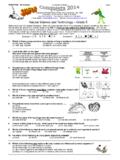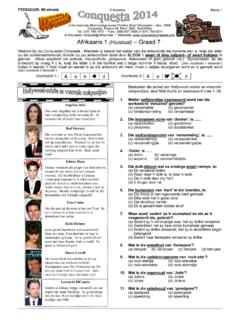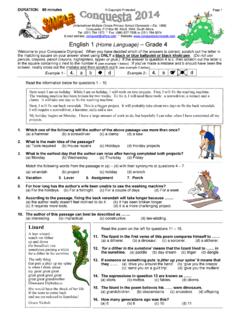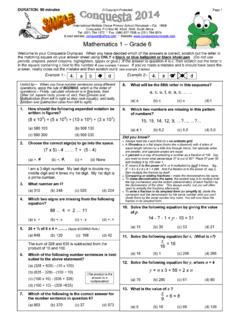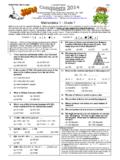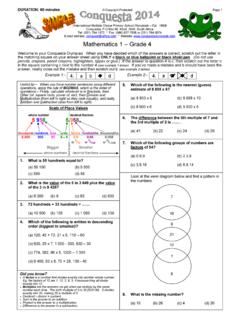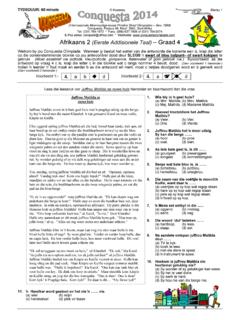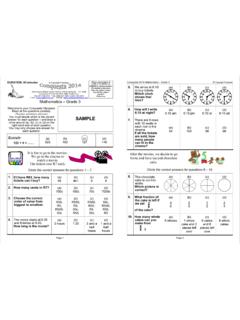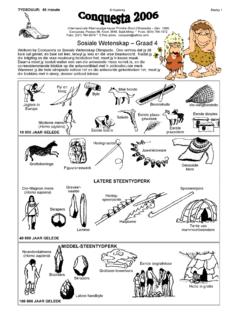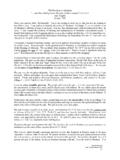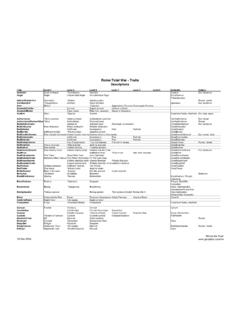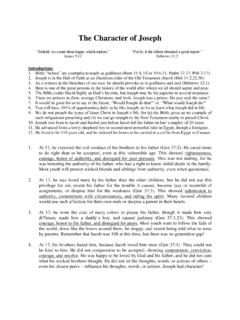Transcription of Survival Daily adaptations include Yearly …
1 Conquesta 2014 natural Science and Technology Grade 6 Copyright Protected Page 2 Survival The amount of light, temperature and availability of food and water will affect the organism and are essential for its Survival . These factors vary in time of day and year. Daily adaptations include : plants closing their flowers at night for protection. animals that are nocturnal and sleep during the day to avoid predators. Yearly adaptations include : animals hibernating, growing thick coats, migrating to warmer areas and storing food. plants losing their leaves in winter and flowers dying off as there are fewer birds or insects to pollinate them.
2 The diagram below on the right shows a fox and an owl both trying to catch a rabbit. 1. The fox and the owl are both (a) finding a mate. (b) competing for food. (c) seeking shelter. (d) migrating for winter. 2. Since green plants make their own food, they are called (a) predators. (b) prey. (c) decomposers. (d) producers. 3. Which structure of a bird is correctly paired with its function? (a) Claws for obtaining food. (b) Wings for eliminating waste. (c) Feathers for breathing. (d) Eyes for growing. 4. Predators such as wolves and coyotes and even bears are moving closer to highly populated areas.
3 This is posing an increased danger to people, so predator populations are being culled (reduced in number). This can have a devastating effect on the ecosystem, because without the natural control (a) prey will also be reduced. (b) prey will become overpopulated. (c) prey will be kept in check. (d) vegetation will be overgrown. 5. A population of mice, some with light-coloured fur and some with dark-coloured fur, is introduced into a field with dark soil. A few generations later, the majority of the mice have dark-coloured fur. Which of the following best explains the change?
4 (a) Light-coloured mice can run faster. (b) Dark-coloured mice have fewer offspring. (c) Light-coloured mice have changed colour over generations. (d) Dark-coloured mice are better able to hide from their predators. 6. When two animals live in the same area and depend on the same organism for food, they are (a) competing. (b) decomposing. (c) germinating. (d) hibernating. 7. Why do some animals hibernate in the winter? (a) To find food for their young. (b) To adapt to environmental changes. (c) To attract a mate. (d) To avoid predators.
5 8. A spider building its web is an example of (a) imitation. (b) instinct. (c) conditioning. (d) imprinting. 9. Young geese will sometimes treat a person as their mother. What is this an example of? (a) Instinct. (b) Imitation. (c) Imprinting. (d) Conditioning. 10. If a rat is given a mild electric shock when it goes to a certain part of its cage, it will eventually avoid going there. This is because of (a) conditioning. (b) instinct. (c) imprinting. (d) imitation. 11. In which environment would a white rabbit be best protected from predators?
6 (a) A shady forest. (b) A snowy field. (c) A grassy lawn. (d) A muddy riverbank. 12. A duck s feathers are covered with a natural oil that keeps the duck dry. This is a special feature ducks have that helps them (a) feed their young. (b) adapt to their environment. (c) attract a mate. (d) search for food. 13. Many birds fly north for the winter. This adaptation is called (a) hibernation. (b) germination. (c) migration. (d) communication. 14. The introduction of a new species to an area will likely negatively impact the native species in that area.
7 Scientists call this introduction of new species (a) bio-invasion. (b) biodiversity. (c) bio-hazardous. (d) bio-magnification. 15. The fur of a snowshoe rabbit changes to white during the winter. This change is an example of (a) adaptation. (b) competition. (c) metamorphosis. (d) metabolism. 16. The owl butterfly has patterns on its wings that look like large eyes. How does this help the butterfly survive? (a) It helps the butterfly fly faster. (b) It helps the butterfly see better. (c) It helps the butterfly scare enemies. (d) It helps the butterfly absorb sunlight.
8 17. Butterflies get food from the flowers of a plant. They also lay their eggs on the leaves of a plant. As the caterpillars develop, they eat the leaves of the plant. How does the plant benefit from butterflies? (a) Butterflies help the plant grow larger flowers. (b) Butterflies' eggs help the leaves to fall off the plant. (c) Butterflies help pollinate flowers so that seeds can form. (d) Butterflies help add nutrients to the nectar of the flowers. 18. The drawing on the left shows a woodpecker using its long, sharp beak to obtain insects. What factor might contribute to the extinction of this species of woodpecker?
9 (a) A new source of food. (b) An overabundance of trees. (c) The use of pesticides in the forest. (d) An increase in the population of insects. 19. A troglobite is any animal that lives in dark caves. These animals have special features that help them live in cool, dark places, like the caves. A population of troglobite cave fish is moved from cave habitat to an open-air pond. The cave-fish population in the open-air pond will most likely (a) increase because their food supply increase. (b) decrease because they are too large to live in a pond. (c) increase because their reproduction rate will increase.
10 (d) decrease because they do not have features needed to survive in sunlight.
